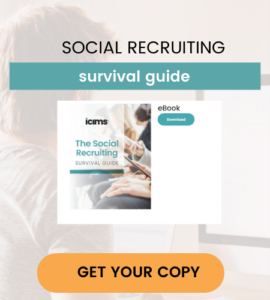- Solutions
- Products
- Community
- Resources
- Company
Create incredible candidate experiences that communicate your brand, mission, and values with recruitment marketing solutions.
Learn moreCommunicate effectively and efficiently with the candidates that can drive your business forward.
Learn moreSelect the right candidates to drive your business forward and simplify how you build winning, diverse teams.
Learn moreHelp your best internal talent connect to better opportunities and see new potential across your entire organization.
Learn moreCommunicate collectively with large groups of candidates and effectively tackle surges in hiring capacity.
Learn moreAccess tools that help your team create a more inclusive culture and propel your DEI program forward.
Learn moreRebound and respond to the new normal of retail with hiring systems that are agile enough to help you forge ahead.
Learn moreAccelerate the hiring of key talent to deliver point of care and support services that meet and exceed your promise of patient satisfaction.
Learn moreAttract and engage candidates with technical competencies, accelerate hiring for much-needed skills, and advance expertise within your valued workforce.
Learn moreSimplify how you recruit finance, insurance, and banking candidates with a unified platform built to match top talent with hard-to-fill roles.
Learn moreYour business strategy depends on your people strategy. Keep both in lockstep with the iCIMS Talent Cloud.
Learn moreBuild an engaging, high-converting talent pipeline that moves your business forward.
Learn moreDeliver the innovation your talent team needs, along with the global scale and security you demand.
Learn moreDeliver tailored technology experiences that delight users and power your talent transformation with the iCIMS Talent Cloud.
Learn moreThe #1 ATS in market share, our cloud-based recruiting software is built for both commercial and large, global employers.
Learn more Talk to salesAttract the best talent for your business with powerful, on-brand career websites that excite candidates and drive engagement.
Learn more Talk to salesBuild talent pipelines, engage candidates with multi-channel marketing campaigns, and use machine learning to automatically surface the right talent for the job.
Learn more Talk to salesEmpower candidates with automated self-service, qualification screening, and interview scheduling through an AI-enabled digital assistant.
Learn more Talk to salesSimplify employee onboarding with automated processes that maximize engagement and accelerate productivity.
Learn more Talk to salesCompliment your sourcing and engagement efforts with award-winning lead scoring and advanced campaign personalization.
Learn more Talk to salesImprove employee experience, retention, and reduce internal talent mobility friction with the iCIMS Opportunity Marketplace.
Learn more Talk to salesVerify skills with game-changing levels of automation and simplicity to improve the quality of hire at scale.
Learn more Talk to salesModernize, streamline, and accelerate your communication with candidates and employees.
Learn more Talk to salesTransform the talent experience by showcasing your authentic employer brand through employee-generated video testimonials.
Learn more Talk to salesGet robust analytics that help you make sense of your data and illuminate your talent pool.
Learn moreSimplify recruiting, dynamically engage talent, and reduce hiring bias with job matching and recruiting chatbot technology.
Learn more Talk to salesGet exclusive intel on industry and market trends along with expert one-on-one advice.
Learn more Talk to salesThe #1 ATS in market share, our cloud-based recruiting software is built for both commercial and large, global employers.
Learn more Talk to salesAttract the best talent for your business with powerful, on-brand career websites that excite candidates and drive engagement.
Learn more Talk to salesBuild talent pipelines, engage candidates with multi-channel marketing campaigns, and use machine learning to automatically surface the right talent for the job.
Learn more Talk to salesEmpower candidates with automated self-service, qualification screening, and interview scheduling through an AI-enabled digital assistant.
Learn more Talk to salesSimplify employee onboarding with automated processes that maximize engagement and accelerate productivity.
Learn more Talk to salesCompliment your sourcing and engagement efforts with award-winning lead scoring and advanced campaign personalization.
Learn more Talk to salesImprove employee experience, retention, and reduce internal talent mobility friction with the iCIMS Opportunity Marketplace.
Learn more Talk to salesVerify skills with game-changing levels of automation and simplicity to improve the quality of hire at scale.
Learn more Talk to salesModernize, streamline, and accelerate your communication with candidates and employees.
Learn more Talk to salesTransform the talent experience by showcasing your authentic employer brand through employee-generated video testimonials.
Learn more Talk to salesGet robust analytics that help you make sense of your data and illuminate your talent pool.
Learn moreSimplify recruiting, dynamically engage talent, and reduce hiring bias with job matching and recruiting chatbot technology.
Learn more Talk to salesGet exclusive intel on industry and market trends along with expert one-on-one advice.
Learn more Talk to salesHow a beloved restaurant hires 40,000+ annually with a great candidate experience.
Learn moreThousands strong, our global community of talent professionals includes creatives, innovators, visionaries, and experts.
Learn moreTogether we’re creating the world’s largest ecosystem of integrated recruiting technologies.
Learn moreExplore our network of more than 300 certified, trusted third-party service and advisory partners.
Learn moreUncover unique market insights, explore best practices and gain access to talent experts across out library of content.
Get resourcesExpert guidance about recruitment solutions, changes in the industry, and the future of talent.
Learn moreStay up to date with the latest terminology and verbiage in the HR software ecosystem.
Learn moreEmployers everywhere improve hiring efficiently and save money using iCIMS. Estimate the potential business value you can achieve.
Learn moreDive into the Class of 2023 Report highlighting this cohort’s expectations and where employers are willing — and able — to meet them.
Watch nowPartner with iCIMS to build the right strategies, processes, and experience to build a winning workforce.
Learn moreExpert guidance about recruitment solutions, changes in the industry, and the future of talent.
Learn moreThe iCIMS Talent Cloud delivers a secure, agile, and compliant platform designed to empower talent teams, job seekers, and partners with advanced data protection and privacy.
Learn moreView press releases, media coverage, and the latest hiring data. See what analysts are saying about iCIMS.
Learn moreiCIMS is the Talent Cloud company that empowers organizations to attract, engage, hire, and advance the talent that builds a winning workforce.
Learn moreGet to know the award-winning leadership team shaping the future of the recruiting software industry.
Learn moreWe believe the future of work isn't something that "happens" to you. It's something you create. We actively create the future of work with our customers every day.
Learn moreiCIMS is committed to being a responsible and ethical corporate citizen, which is why Environmental, Social and Governance (ESG) initiatives are strategic imperatives.
Learn moreStreamline your tech stack and take advantage of a better user experience and stronger data governance with ADP and the iCIMS Talent Cloud.
Learn moreThe combined power of iCIMS and Infor helps organizations strategically align their business and talent objectives.
Learn moreOur award-winning partnership with Microsoft is grounded in a shared desire to transform the workplace and the hiring team experience.
Learn moreOur partnership with Ultimate Kronos Group (UKG) supports the entire talent lifecycle by bringing frictionless recruiting solutions to UKG Pro Onboarding.
Learn moreLet’s get in touch. Reach out to learn more about iCIMS products and services.
Learn more

It’s practically impossible to be on social media without it influencing you in some way. In this case, we’re not talking about the latest fashion or health trends – we’re talking about social media recruiting.
In essence, social media recruitment is exactly what it sounds like – recruiting talent on social media. But it’s more than just posting links to your job descriptions. While that may lead to some applications, you’re playing to a pretty narrow audience. Mainly, people who already follow you on social media and are interested in applying anyway.
Social media recruiting is best thought of as a wing of your larger recruitment marketing strategy. It’s a more organized and comprehensive approach, one that relies on building brand and culture. In marketing speak, social media recruitment is top of the funnel.
Recruiting – hopefully – doesn’t start when a job requisition gets approved. While that’s often the case (and sometimes unavoidable), it’s far faster and cost-effective to start with warm leads. This is where social media recruitment comes in. By engaging potential talent on social media, you’ve given your team a head start.
If you’re a B2C business offering goods or services directly to consumers (think a chain of coffee shops or big box retailer), social media recruiting will lean heavily on your existing brand – and fans. This means things like sharing employee stories and posting about volunteer events alongside new products or locations. These should flow into one another and feel cohesive. Done right, the distinction between “regular” posts and your recruiting posts is virtually indistinguishable.
Things are a little different for B2B. You’re likely speaking to specific job titles and industries. You’re less likely to have a rapid fan base – and you probably won’t be competing as much for airtime with customer-facing content. For B2B organizes, it often makes sense to lean more on company culture, growth opportunities, mission and values.


All social sites are different, and all warrant different approaches. Different platforms reward different types of content, and typically attract different audiences. Knowing who your ideal candidates are – and where they spend their time – is a good first step.
For example, a software provider with big government contracts will probably find more of their ideal candidates on LinkedIn. By contrast, a chain of restaurants may find more success on TikTok or Instagram, where they can show off their locations and costumer experiences.
We’ll get more into tips for successful recruiting on social media below. For now, here are the big social media platforms to consider.
X has evolved plenty over the years, but at its core it’s essentially still a microblogging site. It’s a place where people go to share ideas and videos, and its comments section is where a lot of the engagement happens.
Considered the world’s largest professional network and most frequented social media platform for recruiting. With a vast network of valued connections, your company can easily maintain a high-profile relationship with both active and passive candidates. You can even look to employees for a boost via social distribution, which automatically shares job postings on their profiles for greater exposure, promoting internal referral processes.
With such high user retention, Facebook is the perfect place to engage with job seekers, offer industry insights, and post all your open positions. Facebook offers companies a ‘Job Openings’ tab right from their profile, so candidates can visit one single repository and easily see what’s available.
With its video-only format distinguishing itself amongst the other members of this list, YouTube allows you to broadcast your brand. YouTube enables your company to showcase the value of producing employee and culture-focused recruiting videos regularly.
Instagram is a highly engaging way to promote your brand via pictures, videos, and text captions while appealing to job seekers’ youthful generation.


Growth on social media takes time. For every organization that dials in on great content and builds a thriving, engaged audience, dozens will let their social media dreams fall by the wayside. Distraction and competing interests for your team’s time can be hugely detrimental.
Whatever your social media goals are, your team needs a plan to get there.
Start with research. It’s helpful to find out how your company is already using social media platforms and its goals.
To attract candidates using social media, you could share photos on Facebook or Instagram of team accomplishments and how members are recognized. This shows candidates that your organization is committed to its employees.
As we discussed above, no social media strategy is complete without knowing which platforms you want to be on – and why. Often, this will come down to the type of talent you’re trying to attract, where they spend their time, and how they like to be engaged.
At the most basic level, this means knowing who your ideal candidates are. Knowing as much as you can about them makes it easier for your company to target better cultural fits and create interesting content. This requires some research to get a view into their interests, motivations, frustrations, etc.
Since recruitment is forever changing, keep in mind that levering social media goes beyond posting a job ad to multiple social media platforms. That said, it’s your organization’s responsibility to invest in a talent platform that takes recruitment seriously and supports the quality candidate engagement platform.
To connect with today’s candidates, you need to meet them where they are—on the go. Text recruiting and engagement is a modern, streamlined, and accelerated approach to communication with candidates and employees.
The overall goal of social recruiting is to build a large, high-quality talent pool. To ensure that you reach your goals, your company must first create goals against which you measure your success. Such plans may include:
You can also measure how social recruiting directly impacts the bottom line by reporting on:
Before you implement your social media strategy, start tracking key metrics on your current sourcing and recruiting efforts. Then, set goals that you would like to accomplish with social recruiting.
Evaluate how you can feature your company culture and brand on social media. The image you portray on social media will impact who applies for your company. A great way to get people excited about your company is by showing what makes your company a unique and exciting place to work.
Applicants are interested in learning about the types of people they would potentially work with at companies when they do their research.
Company social media accounts provide candidates with a glimpse into a company’s culture, employees, company morale, and unique offerings. These factors help candidates determine whether that company is a good place to work. Amp up your social recruitment efforts with a solution that makes it easy to cultivate a social media presence and connect with more job seekers. With the iCIMS Talent Cloud, social media recruiting can be your sourcing powerhouse.
A strong employer brand sets the tone for business success. It affects the candidate’s perception of your culture, so it’s essential to get it done right with effective recruitment marketing software.
Don’t be afraid to advertise for open positions on social media in an engaging way. This may bring awareness to potential applicants who may not even be actively looking for a job but are interested in connecting with your company for the future.
Employee referral programs are a handy recruiting tool. You can use social media to engage existing employees in the hiring process. Educate your employees and managers on using social networks for professional purposes and encouraging them to get involved. Employees can then post open requisitions to their social networks. They can also post relevant industry news that may interest potential candidates.


Social media is a mechanism for conveying your company culture to potential recruits and attracting new staff. You can brand your social media channels, post photos, and host videos. Customers and job seekers should be encouraged to participate in discussions, and employees should promptly address questions and comments.
Social media allows potential recruits to get a feel for what the company is like before they apply. By encouraging potential recruits to get to know the company culture before accepting a position, you ensure the candidate is the right fit for the company.
Many people that are not currently looking for a job are still using social networks. But some of these professionals may be an excellent fit for the role you are looking to fill and might apply if they knew you had a vacancy. Even if many of these passive candidates have no current interest, you can begin building relationships before they decide to look for a new job. Using social media, you can significantly expand your talent pool by getting your jobs in front of passive candidates.
Accounts on X, Facebook and LinkedIn are all free to set up. Therefore, one advantage of social media is its potential to lower recruitment costs. Posting job openings on social networks are more likely to deliver results than a single description on a job board. Many organizations have saved large sums of money by leveraging social media’s power, which allows them to cut back on recruiting agencies and expensive job boards.
As you can see, there’s a ton of benefit to using social media for recruitment. From building up your employer brand, to sourcing and engaging candidates. To learn more about this topic, see our Social recruiting survival guide.
and receive free tips on how to attract, engage, hire, & advance the best talent.





